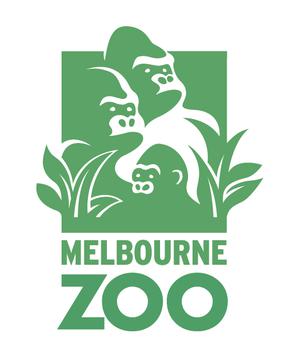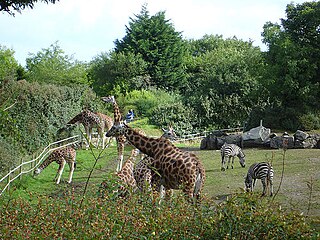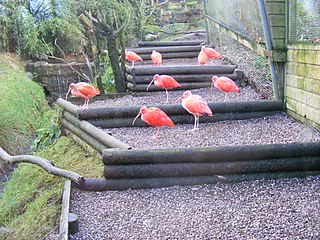
Perth Zoo is a 17-hectare (41-acre) zoological park in South Perth, Western Australia. The zoo first opened in 1898 and by 2011 housed 1258 animals of 164 species and an extensive botanical collection. It is a full institutional member of the Zoo and Aquarium Association (ZAA) and the World Association of Zoos and Aquariums (WAZA).

Melbourne Zoo is a zoo in Melbourne, Australia. It is located within Royal Park in Parkville, approximately 4 kilometres (2.5 mi) north of the centre of Melbourne. It is the primary zoo serving Melbourne. As of 2021, the zoo contains 3742 animals comprising 243 species, from Australia and around the world. The zoo is accessible via Royal Park station on the Upfield railway line, and is also accessible via tram routes 58 and 19, as well as by bicycle on the Capital City Trail. Bicycles are not allowed inside the zoo itself.

Chester Zoo is a zoo in Upton-by-Chester, Cheshire, England. Chester Zoo was opened in 1931 by George Mottershead and his family. The zoo is one of the UK's largest zoos at 51 hectares and the zoo has a total land holding of approximately 160 hectares.

Belfast Zoological Gardens is a zoo in Belfast, Northern Ireland. It is in a relatively secluded location on the northeastern slope of Cavehill, overlooking Belfast's Antrim Road. Opened in 1934, it is the second-oldest zoo in Ireland, after Dublin Zoo, which opened in 1831.

Shoalhaven Zoo, formerly the Nowra Animal Park, is an animal park on the South Coast of New South Wales, Australia.

Exmoor Zoo is a conservation centre in Exmoor, North Devon, England. The zoo developed from Exmoor Bird Gardens, opened on the site of a farm in 1982. The current owners took over in 1993, and have enlarged and developed the zoo, now specialising in the conservation of smaller animals. The zoo has been a member of BIAZA, the British and Irish Association of Zoos and Aquariums, since 1995 and recently became a member of EAZA in 2018.

The San Antonio Zoo is an Association of Zoos and Aquariums–accredited zoo in Midtown San Antonio, Texas, United States. It is located in the city's Brackenridge Park. San Antonio Zoo is a 50+ acre zoo home to over 750 species, some of which are endangered or extinct in the wild, and an annual attendance of more than 1 million. It also runs non-animal attractions, such as the 2 ft narrow gauge San Antonio Zoo Eagle train ride, which first opened in 1956.

Shanghai Zoological Park, or commonly Shanghai Zoo in short, is the one of the two main zoos in Shanghai. It is located near the township of Hongqiao and is administratively in Changning District. Shanghai Zoo was formerly known as " Xijiao Park", which is still a common name used locally for the zoo.

Moonlit Sanctuary Wildlife Conservation Park is a 25-acre (10 ha) biopark within the Pearcedale Conservation Park located at Pearcedale on the Mornington Peninsula near Melbourne, Australia. It aims to display the fauna that was found in the Mornington Peninsula and Western Port Biosphere Reserve prior to European settlement as well as working towards the recovery of threatened Australian fauna. The park is open all year except on Christmas Day. The sanctuary, as part of Pearcedale Conservation Park, is an institutional member of the Zoo and Aquarium Association (ZAA). It is ECO Certified at the Ecotourism level by Ecotourism Australia.
Halls Gap Zoo is a country 53-acre (21 ha) zoo located about 7 kilometres (4.3 mi) from Halls Gap, Victoria, Australia. From the zoo you can see Grampians National Park. It is Victoria's largest regional zoo, holding over 120 native and exotic species.

Banham Zoological Gardens is a 50-acre (20 ha) zoo in Banham, Norfolk, England. The zoo, which in 2024 was reported to be a home to more than 2,000 animals, opened to the public in 1968, became a charity in 2013, and has since been often awarded the prize of Norfolk's Top Attraction, by numerous different organisations, with an annual visitor attendance of in excess of 200,000 people. It is part of the Zoological Society of East Anglia, a registered charity which also owns Africa Alive Zoological Reserve near Lowestoft, Suffolk.

Barcelona Zoo is a zoo in the Parc de la Ciutadella in Barcelona, Catalonia, Spain. The zoo used to be internationally known as the home of Snowflake, the only known albino gorilla, who died in 2003.

Billabong Zoo is a 10-acre (4.0 ha) wildlife park and koala breeding centre located in Port Macquarie, New South Wales, Australia. It was opened in 1986, and features a wide variety of Australian and exotic animals.

Featherdale Wildlife Park is a zoo located in Doonside, Sydney, Australia. The park is located in Sydney's west, approximately 40 km (25 mi) from Sydney's CBD. The park contains various species native to Australia, and is known to be one of the world's largest collections of Australian fauna. The facility provides displays, events and interactive experiences. The site covers 3.29 hectares, ranging from animal enclosures and display areas to visitor facilities, including picnic spaces, shops and basic amenities. It specialises in Australian native wildlife and birds, as well as reptiles and marsupials. The premises is accredited by the Zoo Aquarium Association Australia.

Wildlife HQ Zoo, is located at the Big Pineapple, Woombye, Queensland on the Sunshine Coast, Queensland and opened in November 2013. In March 2014 many animals were relocated from the now closed Alma Park Zoo.

Gorge Wildlife Park is a privately-owned sanctuary in the Australian state of South Australia. It is at Cudlee Creek in the Adelaide Hills and continues to be operated by the same family that established it in 1965. It is 30 km northeast of Adelaide. Situated on 14 acres of land, under shaded trees, paths meander among the largest privately owned collection of Australian animals. The park provides contact with a range of Australian native animals as well as exhibits of Australian and exotic animals and birds. A feature is the opportunity for visitors to hold a koala.

Darling Downs Zoo is a zoo situated in Pilton, Queensland, Australia. The zoo is divided into four separate geographical areas featuring animals mostly from Africa, South America, South-East Asia and Australia.
Ranger Red's Zoo & Conservation Park, formerly Peel Zoo, is a zoo and wildlife sanctuary located on the banks of the Murray River in Pinjarra, Western Australia. It is a member of the Zoo and Aquarium Association.

Symbio Wildlife Park is a privately owned medium sized zoo located in Helensburgh, New South Wales, south of Sydney and in close proximity to the City of Wollongong. Beginning in 1975 as a native Australian wildlife park, Symbio later expanded its holdings with a number of different animals from other countries also, and has contributed to conservation work and captive breeding programs for both Australian and exotic animals. In 2021 the park established specialty built captive-breeding facilities for native vulnerable and endangered Bellinger River snapping turtles, Manning River snapping turtles and Stuttering frogs. Among Symbio's animal residents is an albino echidna named Leo.

Mogo Wildlife Park is a small privately owned zoo in Mogo, on the south coast of New South Wales, Australia.
























